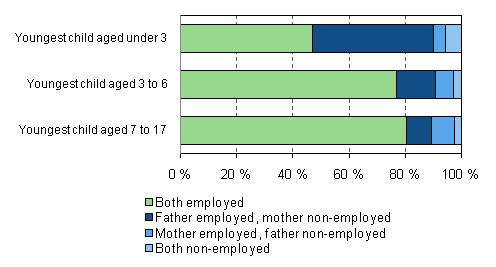3. Both parents of families with children are usually employed
If a family with children has two carers both of them are usually employed. Both the father and the mother were employed in around 70 per cent of two-carer families with children in 2009. When the children are small the father usually works and the mother stays at home caring for the children. However, this arrangement lasts for a relatively short time period and the so-called dual-earner model becomes usual as the youngest child grows older. Both parents are employed in nearly 80 per cent of the two-parent families where the youngest child is aged over three (Figure 9).
Figure 9. Labour market status of parents in dual-carer families with children by age of youngest child in 2009

In three out of four of the two-parent families where the youngest child was aged under one the father was working and the mother was either on family leave or otherwise caring for the children at home. If the youngest child was aged between one and two this situation only applied to about every third family and in every second family the mother, too, had returned to work.
Thus, in respect of the parents’ participation in working life the set-up is still very traditional in the majority of families with small children. The mother was working while the father cared for the children in only about one per cent of the families with children aged under three in 2009.
Source: Labour force survey 2009. Statistics Finland
Inquiries: Laura Hulkko (09) 1734 2611, Anna Pšrnšnen (09) 1734 2607, tyovoimatutkimus@stat.fi
Director in charge: Riitta Harala
Updated 12.10.2010
Official Statistics of Finland (OSF):
Labour force survey [e-publication].
ISSN=1798-7857. 16 2009,
3. Both parents of families with children are usually employed
. Helsinki: Statistics Finland [referred: 19.4.2025].
Access method: http://stat.fi/til/tyti/2009/16/tyti_2009_16_2010-10-12_kat_003_en.html

